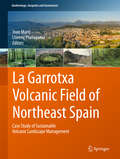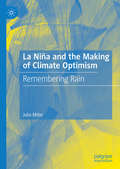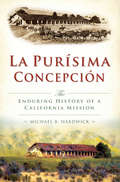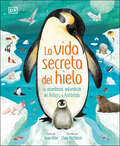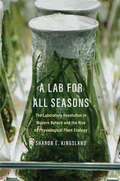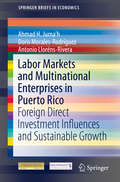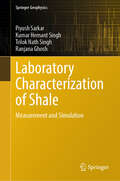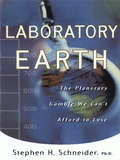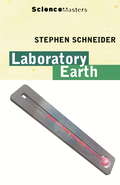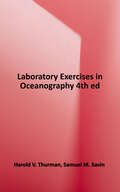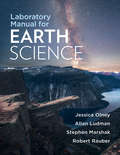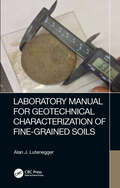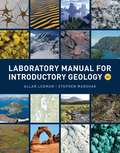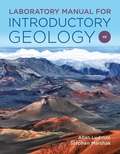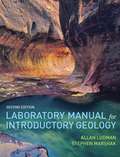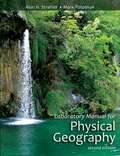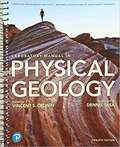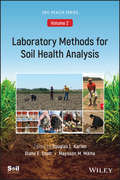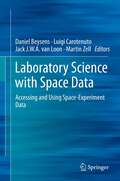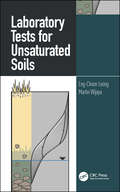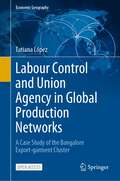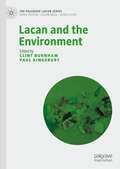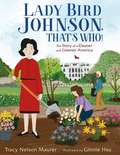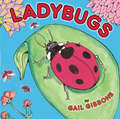- Table View
- List View
La Garrotxa Volcanic Field of Northeast Spain
by Joan Martí Llorenç PlanagumàThis informative book takes readers on an enjoyable journey through the La Garrotxa volcanoes. In addition to a general description of the main geological and volcano logical values of the region, it also provides a detailed account of the history of the region, its biological diversity, and its cultural heritage including architecture, folklore and gastronomy. La Garrotxa Volcanic Zone was declared a Natural Park in 1982 to protect the numerous sites of special interest that are found in this region. The Natural Park has been pioneering in many initiatives aimed at preserving the landscape and natural values and promoting awareness of the area within the community. An important part of this book is dedicated to the insights into the educational programs and outreach developed to disseminate the main values of this region. It shows how sustainable tourism has been implemented and the management plan that has been designed to preserve such important natural and cultural values. Including local experts’ views on the topics covered, this book will appeal to a general audience interested not only in visiting the area but also in gaining insights into an example of geoheritage and geoconservation that has successfully integrated of education, tourism, planning and environmental management.
La Niña and the Making of Climate Optimism: Remembering Rain
by Julia MillerThis book examines the deep connection Australians have with their climate to understand contemporary views on human-induced climate change. It is the first study of the Australian relationship with La Niña and it explains how fundamental this relationship is to the climate change debate both locally and globally. While unease with the Australian environment was a hallmark of early settler relations with a new continent, this book argues that the climate itself quickly became a source of hope and linked to progress. Once observed, weather patterns coalesced into recognizable cycles of wet and dry years and Australians adopted a belief in the certainty of good seasons. It was this optimistic response to climate linked to La Niña that laid the groundwork for this relationship with the Australian environment. This book will appeal to scholars and students of the environmental humanities, history and science as well as anyone concerned about climate change.
La Popa Basin, Nuevo León and Coahuila, Mexico: Halokinetic Sequences and Diapiric Structural Kinematics in the Field (Springer Geology)
by Timothy Lawton Katherine Giles Mark RowanThis book describes the two excursions accessed from the Monterrey International Airport on the north side of Monterrey, Nuevo León, Mexico. Excellent exposures of salt diapirs and flanking strata in La Popa basin, northeastern Mexico, contain world-class examples of salt–sediment interaction that provided the basis for the concept of halokinetic sequences. The basin also contains one of the first secondary salt welds described in outcrop. Two one-day excursions described here provide an easily accessible overview of salt–sediment relations within a short distance of Monterrey, Nuevo León, Mexico. Excursion 1 constitutes an introduction to basin stratigraphy, an introduction to halokinetic sequences at El Papalote diapir, and a visit to a salt-cored detachment fold near Hidalgo, Nuevo León. Excursion 2 is a visit to La Popa salt weld, where stops at several parts of the weld permit comparison of different structural styles developed along the weld. Each excursion begins and ends at the Marriott Courtyard Aeropuerto Hotel, near the Monterrey airport.
La Purisíma Concepción: The Enduring History of a California Mission (Brief History)
by Michael R. HardwickIn two centuries, La Purísima Concepción went from a fledgling frontier mission to a renowned California State Historic Park. Once home to many Spanish soldiers, settlers and hundreds of Chumash Indians, La Purísima held the seat of the California Mission government under Father Mariano Payeras. It withstood catastrophic events, including widespread disease in early years and a great Southern California earthquake in 1812. Emerging from ruins for the last time in 1934, after restoration by the Civilian Conservation Corps, structures appear today as they did in the early nineteenth century. The uniquely restored California Mission complex operates as a state park in a pastoral setting. Author and archivist Michael R. Hardwick chronicles the story of La Purísima and the resilient people and culture that made a lasting influence.
La vida secreta del hielo (The Magic and Mystery of the Natural World)
by Jason BittelAdéntrate en 'La vida secreta del hielo' y embarca en un viaje increíble por los polos de la tierra.Osos polares, pingüinos y hielo se deslizan por las páginas de este colorido libro, que combina hermosas ilustraciones y fotos para ayudar a los niños más entusiastas a aprenderlo todo sobre el Ártico y la Antártida. Desde ríos helados hasta volcanes antárticos, descubrirán la increíble vida secreta de las regiones polares de la Tierra. También descubrirán cómo pueden ayudar a cuidar el Ártico y la Antártida.'La vida secreta del hielo' lleva a los niños por un deslumbrante viaje bajo cero, mostrándoles cuán increíbles son los polos de la tierra, qué plantas y animales viven cerca de ellos y cómo podemos ayudarlos. Incluye una multitud de vida polar, además de datos sorprendentes sobre cómo se forman los icebergs, cómo los animales sobreviven en el frío helado y cómo los científicos estudian la Antártida.Enter the world of the Arctic and Antarctic for an incredible journey around Earth&’s icy poles.Polar bears, penguins, and ice glide across the pages of this colorful book, which combines gorgeous illustrations and photos to help young enthusiasts learn all about the Arctic and Antarctic. From icy rivers to Antarctic volcanoes, they&’ll discover the incredible secret life of Earth&’s polar regions. They&’ll also find out how they can help take care of the Arctic and Antarctic themselves.'La vida secreta del hielo' takes children on a fascinating sub-zero journey, showing them just how amazing Earth&’s poles are, which plants and animals live near them, and how we can help them. It includes a multitude of polar life, plus amazing facts on how icebergs are formed, how animals survive in the freezing cold, and how scientists study the Antarctic.
A Lab for All Seasons: The Laboratory Revolution in Modern Botany and the Rise of Physiological Plant Ecology
by Sharon E. KingslandThe first book to chronicle how innovation in laboratory designs for botanical research energized the emergence of physiological plant ecology as a vibrant subdiscipline Laboratory innovation since the mid-twentieth century has powered advances in the study of plant adaptation, evolution, and ecosystem function. The phytotron, an integrated complex of controlled-environment greenhouse and laboratory spaces, invented by Frits W. Went in the 1950s, set off a worldwide laboratory movement and transformed the plant sciences. Sharon Kingsland explores this revolution through a comparative study of work in the United States, France, Australia, Israel, the USSR, and Hungary. These advances in botanical research energized physiological plant ecology. Case studies explore the development of phytotron spinoffs such as mobile laboratories, rhizotrons, and ecotrons. Scientific problems include the significance of plant emissions of volatile organic compounds, symbiosis between plants and soil fungi, and the discovery of new pathways for photosynthesis as an adaptation to hot, dry climates. The advancement of knowledge through synthesis is a running theme: linking disciplines, combining laboratory and field research, and moving across ecological scales from leaf to ecosystem. The book also charts the history of modern scientific responses to the emerging crisis of food insecurity in the era of global warming.
Labor Markets and Multinational Enterprises in Puerto Rico
by Ahmad H. Juma'H Doris Morales-Rodriguez Antonio Lloréns-RiveraThis book expresses the reasons to embark on a production management system and begin a journey to a better social and economic life in Puerto Rico. Among the population of Puerto Rico there is a simultaneous presence of a high rate of unemployment and a well-educated workforce. How has this happened? How could the country overcome this economic situation and return to a path of sustainable economic growth in the short and long term? The study here presented introduces an objective and scientific input on these economic issues that are impacting the Puerto Rican society. Achieve greater economic and social welfare in a geographic area is based on increasing individual productivity that workers and employees can unfold in different workplaces, business and industries. The increase in productivity of the economy of Puerto Rico requires both individual effort and enterprise work.
Laboratory Characterization of Shale: Measurement and Simulation (Springer Geophysics)
by Piyush Sarkar Kumar Hemant Singh Trilok Nath Singh Ranjana GhoshThis book introduces to the reader an analytical procedure to characterize the organic-rich Indian Gondwana shale in terms of its elastic, petrophysical, geochemical, and microstructural properties using state-of-the-art laboratory measurements and accounting for the elastic anisotropy, pore microstructure along with rock physics models, image segmentation techniques, and pore network models. As compared to sandstone, shale possesses a more complex origin, strong heterogeneity, and is anisotropic in nature. This makes the characterization of shale rock and the assessment of the potential of the reservoir extremely challenging. The laboratory-measured properties of the reservoir rock are important for the evaluation of the potential of the reservoir rock. These input parameters are utilized to predict variables, build a petrophysical model, and set up strategies in several domains of petroleum engineering and petrophysics. The authors presented the case studies for the identification of prospective shale formation zones in the Indian Gondwana basin that might be used for commercial gas and/or oil production. The scope of this book covers the interest of all researchers and academicians involved in source-rock characterization at the laboratory scale. Furthermore, the source-rock evaluation methods and their many nuances covered here provide excellent reading for geoscience graduates.
Laboratory Earth: The Planetary Gamble We Can't Afford To Lose
by Stephen H. SchneiderLaboratory Earth taps the relevant knowledge from physical, biological, and social sciences needed to study the planet holistically. This so-called Earth Systems Science fosters a new way to understand the Earth and our roles as inhabitants, with the purpose of building solutions to the bewildering global environment and overdevelopment. Educational, business, health, and governmental organizations often dissect the world into narrow but highly specialized disciplines--economics, ecology, cardiology, meteorology, glaciology, or political science, to name a few. But real world problems, like urban sprawl, public health, poverty, toxic waste, economic development, the ozone hole, or global warming, do not fit neatly into disciplinary boxes. However, author Stephen Schneider asserts that these contemporary issues must be viewed as systems of interconnected subelements. This is especially true for global environmental problems, since they arise from increasing numbers of people demanding higher standards of living and willing to use the cheapest available technologies to pursue these growth-oriented goals, even if the unintended byproducts include land degradation, toxic pollutants, species extinctions, or global climate change. To first understand and then solve such problems, we must learn to view the Earth and our socioeconomic engine as one integrated system. Schneider, who in the 1970s predicted global warming would become "demonstrable” by the turn of the century, chooses that debate to illustrate how this twenty-first century Earth Systems Science approach works, introducing us to the sharp controversies and highly visible debates among climatologists, ecologists, economists, industrialists, and political interests over the seriousness and solutions to the climate change crisis. He begins with a fascinating journey to the beginning of geologic time on Earth and traces from there the coevolution of climate and life over the next four billion years. Along the way we learn about the Gaia Hypothesis, the demise of the dinosaurs, and the likelihood of an impending ice age. Schneider traces our climatic history not only from the beginning and up to the twentieth century, but deep into the twenty-first as well. He depicts the next one hundred years as a potentially perilous period for climate and life--unless we citizens of Earth recognize and then work to control the unintended global scale experiment we are foisting on ourselves and all other life on "Laboratory Earth. ” This "lab” is not built of glass, wires, and tubes, but of insects, soils, air, oceans, birds, trees, and people. While no honest scientist can claim to have clairvoyant vision into the twenty-first century, Schneider optimistically demonstrates that enough is already known to command our attention and to insure that the juggernaut of human impacts on Earth doesn’t turn into a gamble we can’t afford to lose.
Laboratory Earth (SCIENCE MASTERS)
by Stephen H SchneiderAn extremely readable account on the scientific essentials of the global warming debateThe possibility of global climatic change as a result of increasing numbers of people requiring higher stands of living has spawned an international controversy over the appropriateness of controls on deforestation and energy use. In order to address the political debate it is essential to understand the scientific background that underlies this problem. Laboratory Earth takes the reader on a journey from the dawn of earth's climate and biological evolution through the era of the dinosaurs, past the Ice Age and into the shadowy environmental future increasingly dominated by human activities. In the final analysis it will be human values more than scientific methods that must be applied to decide how to gamble with the fate of the earth.
Laboratory Exercises in Oceanography
by Harold V. Thurman Samuel M. SavinA stand-alone lab manual for any intro oceanography lab course.
Laboratory Manual for Earth Science
by Jessica Olney Allan Ludman Stephen Marshak Robert RauberGive students the most hands-on, applied, and affordable lab experience. Laboratory Manual for Earth Science engages students with Earth science concepts through an ideal balance of hands-on activities, quantitative calculations, map-based exercises, and critical thinking questions. “Geotours” and “What Do You Think?” exercises in every chapter define the manual’s unique emphasis on applying lab work to real-world site explorations and considering how Earth science concepts inform their lives and the world around them. And a low price with flexible custom options ensures students get the most affordable lab experience.
Laboratory Manual for Geotechnical Characterization of Fine-Grained Soils
by Alan J. LuteneggerThis manual presents procedures for performing advanced laboratory tests on fine-grained soils. It covers characterization tests, which determine soil composition and quantify the individual components of a soil, and behavioral tests, such as the Atterberg Limits tests that demonstrate how the fines fraction of a soil reacts when mixed with water and the Linear Shrinkage Test that demonstrates how much a soil shrinks. The material goes beyond traditional evaluation of basic soil behavior by presenting more advanced laboratory tests to characterize soil in more detail. These tests provide detailed compositional characteristics which identify subtle changes in conditions and vertical variations in the soil, and which help to explain unusual behavior. A unique compilation of information on key soil tests Combines characterization tests with behavior tests The book suits graduate students in geotechnical engineering, as well as practitioners and researchers.
Laboratory Manual for Introductory Geology
by Allan Ludman; Stephen MarshakThe Third Edition has been thoroughly updated to help make your geology lab more active and engaging. This edition features new “What Do You Think” mini-cases that promote critical thinking, new and vastly-improved topographic maps, and updated, detailed reference figures in every chapter.
Laboratory Manual for Introductory Geology
by Allan Ludman Stephen MarshakThis lab manual offers a variety of activities for an active, applied student experience and increased flexibility for instructors. Every lab includes "What Do You Think?" exercises in which students apply the course concepts to real-world scenarios. New Geotours Google Earth exercises get students exploring and analyzing real-world sites. A new, unique chapter on global change in which students explore how the Earth will evolve during their lifetime has been added to this edition.
Laboratory Manual for Introductory Geology (Second Edition)
by Allan Ludman Stephen MarshakThe second edition contains inquiry based exercises, rock group labs, and a modern treatment of geologic mapping.
Laboratory Manual for Physical Geography
by Alan H. Strahler Mark PotosnakThis student-friendly, interactive lab manual presents activities and experiments that enhance students’ ability to both visualize and understand physical geographic topics. In a clear and concise tone, the manual requires students to first apply information they learned and then to critically evaluate the information.
Laboratory Manual in Physical Geology
by Vincent S. Cronin Dennis Tasa American Geological Institute Staff National Association of Geoscience Teachers StaffLaboratory Manual in Physical Geology offers an inquiry and activities-based approach that builds skills and gives students a complete learning experience in the lab. This user-friendly lab manual examines the basic processes of geology and their applications to everyday life, featuring an exceptional illustration program by Dennis Tasa and contributions from over 200 highly regarded geologists and geoscience educators. <P><P> With the 12th Edition, lead author Vince Cronin and the newly formed NAGT editorial panel deliver the latest data and science, including new climate/environmental change and hazards/disasters lab activities.
Laboratory Methods for Soil Health Analysis (ASA, CSSA, and SSSA Books #192)
by Douglas L. Karlen Diane E. Stott Maysoon M. MikhaLaboratory Methods for Soil Health Analysis Analyzing, comparing, and understanding soil health data The maintenance of healthy soil resources is instrumental to the success of an array of global efforts and initiatives. Whether they are working to combat food shortages, conserve our ecosystems, or mitigate the impact of climate change, researchers and agriculturalists the world over must be able to correctly examine and understand the complex nature of this essential resource. These new volumes have been designed to meet this need, addressing the many dimensions of soil health analysis in chapters that are concise, accessible and applicable to the tasks at hand. Soil Health, Volume Two: Laboratory Methods for Soil Health Analysis provides explanations of the best practices by which one may arrive at valuable, comparable data and incisive conclusions, and covers topics including: Sampling considerations and field evaluationsAssessment and interpretation of soil-test biological activity Macro- and micronutrients in soil quality and health PLFA and EL-FAME indicators Offering a practical guide to collecting and understanding soil health data, this volume will be of great interest to all those working in agriculture, private sector businesses, non-governmental organizations (NGOs), academic-, state-, and federal-research projects, as well as state and federal soil conservation, water quality and other environmental programs.
Laboratory Science with Space Data
by Martin Zell Luigi Carotenuto Jack J.W.A. van Loon Daniel BeysensFor decades experiments conducted on space stations like MIR and the ISS have been gathering data in many fields of research in the natural sciences, medicine and engineering. The EU-sponsored Ulisse Internet Portal provides metadata from space experiments of all kinds and links to the data. Complementary to the portal, this book will serve as handbook listing space experiments by type of infrastructure, area of research in the life and physical sciences, data type, what their mission was, what kind of data they have collected and how one can access this data through Ulisse for further research. The book will provide an overview of the wealth of space experiment data that can be used for research, and will inspire academics (e.g. those looking for topics for their PhD thesis) and research departments in companies for their continued development.
Laboratory Tests for Unsaturated Soils
by Eng-Choon Leong Martin WijayaThe testing of unsaturated soils requires greater care and effort than that of saturated soils. Although unsaturated soil mechanics has been embraced by geotechnical engineering, engineering practice has not yet caught up as the characterization of unsaturated soils is difficult and time-consuming, and made harder still by a lack of standards. Laboratory Tests for Unsaturated Soils collates test procedures to cover all laboratory tests for characterising unsaturated soils. It covers the background, theory, test procedures, and interpretation of test results. Each test procedure is broken down into simple stages and described in detail. The pitfalls of each test and the interpretation of the test results are explained. Test data and calculation methods are given, along with many numerical examples to illustrate the methods of interpretation and to offer the presentation of typical results. The book is especially useful for students and researchers who are new to the field and provides a practical handbook for engineering applications.
Labour Control and Union Agency in Global Production Networks: A Case Study of the Bangalore Export-garment Cluster (Economic Geography)
by Tatiana LópezThis book puts Indian garment workers and their organisations at the centre of the analysis. Taking the Bangalore export-garment cluster as a case study, the book explores the conditions that enable but also constrain the capacities of garment workers’ unions to build collective power vis-à-vis employers and thereby improve their conditions. Drawing on theoretical concepts from labour geography, relational economic geography, and Global Production Network (GPN) analysis, the book highlights, on the one hand, how the complex labour control regime in the Bangalore export-garment cluster poses manifold challenges and constraints for workers’ and unions’ collective agency. On the other hand, the book illustrates the various networked agency strategies that local garment unions in Bangalore have developed over the years to overcome these constraints by tapping into coalitional power resources from worker, consumer and labour rights organisations in the Global North.This book is therefore highly relevant for economic geographers and other scholars interested in dynamics of labour and development in GPNs as well as for unionists and labour rights activists committed to improving working conditions in the global garment industry.This is an open access book.
Lacan and the Environment (The Palgrave Lacan Series)
by Clint Burnham Paul KingsburyIn this exciting new collection, leading and emerging Lacanian scholars seek to understand what psychoanalysis brings to debates about the environment and the climate crisis. They argue that we cannot understand climate change and all of its multifarious ramifications without first understanding how our terrifying proximity to the real undergirds our relation to the environment, how we mistake lack for loss and mourning for melancholy, and how we seek to destroy the same world we seek to protect. The book traces Lacan’s contribution through a consideration of topics including doomsday preppers, forest suicides, Indigenous resistance, post-apocalyptic films, the mathematics of climate science, and the relevance of Kant. They ask: What can you do if your neighbour is a climate change denier? What would Bartleby do? Does the animal desire? Who is cleaning up all the garbage on the internet? Why is the sudden greening of the planet under COVID-19 no help whatsoever? It offers a timely intervention into Lacanian theory, environmental studies, geography, philosophy, and literary studies that illustrates the relevance of psychoanalysis to current social and environmental concerns.
Lady Bird Johnson, That's Who!: The Story of a Cleaner and Greener America
by Tracy Nelson MaurerLady Bird Johnson, That's Who! is Tracy Nelson Maurer's lively picture book biography of Lady Bird Johnson, with a focus on her environmentalist passion and legacy as First Lady.Who fought to stop pollution? Who helped make America cleaner and greener? Lady Bird Johnson, That's Who!Claudia Alta Taylor was a lonely girl, shy as a butterfly growing up in Texas. She never dreamed she'd blossom into a visionary leader whose love for wildflowers, beautiful landscapes, and building community compelled her to lead the effort to combat pollution in the United States. A lifelong environmentalist, Lady Bird Johnson embraced her platform as First Lady to promote policy that beautified America’s roadways, waterways and parks, inspiring people to take pride in the places they live.With elements of women’s history, civics, and conservationism, this is a timely and informative picture book biography.
Ladybugs
by Gail GibbonsEverything you ever wanted to know about ladybugs— and why they're crucial to our environment. When you think of a ladybug, you might picture a little red beetle with seven black spots on its back—but did you know there are thousands of types of ladybugs, spread across the world? With her signature combination of simple text, clear illustrations, and simple diagrams, Gail Gibbons explores the world of ladybugs. These small beetles live on six of the seven continents, ranging in size, markings, and coloration. Follow a ladybug through the four stages of its development from egg to adult, and learn about its behavior and habitat—plus, how little ladybugs help protect crops by eating harmful insects. Bright illustrations and an easy-to-read text make this ideal for young readers studying the natural world. A page of quick ladybug facts and resources for learning more are included.
